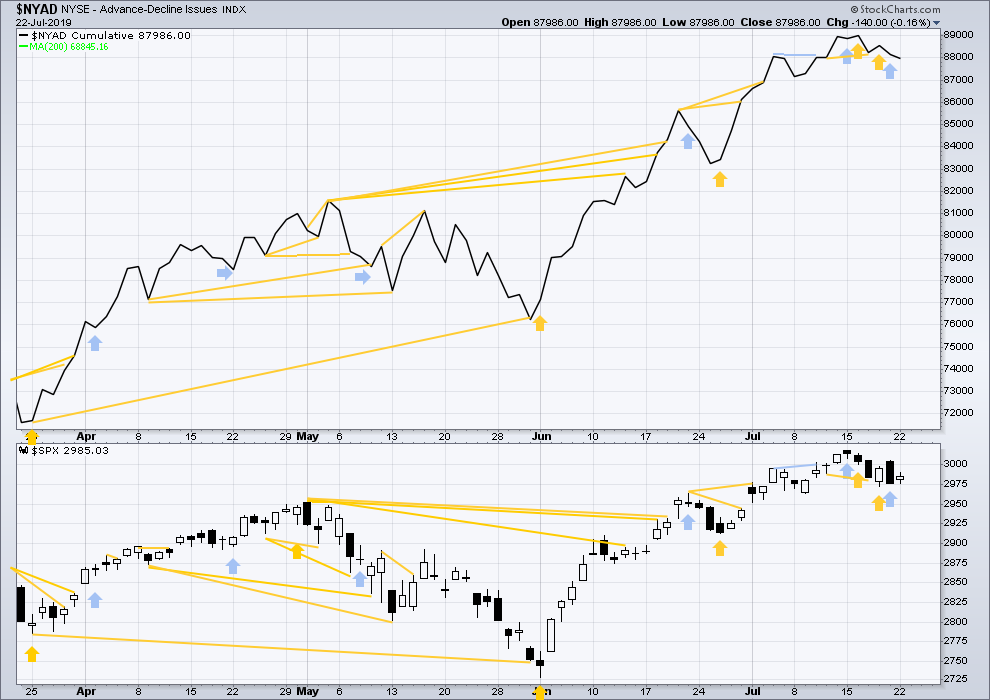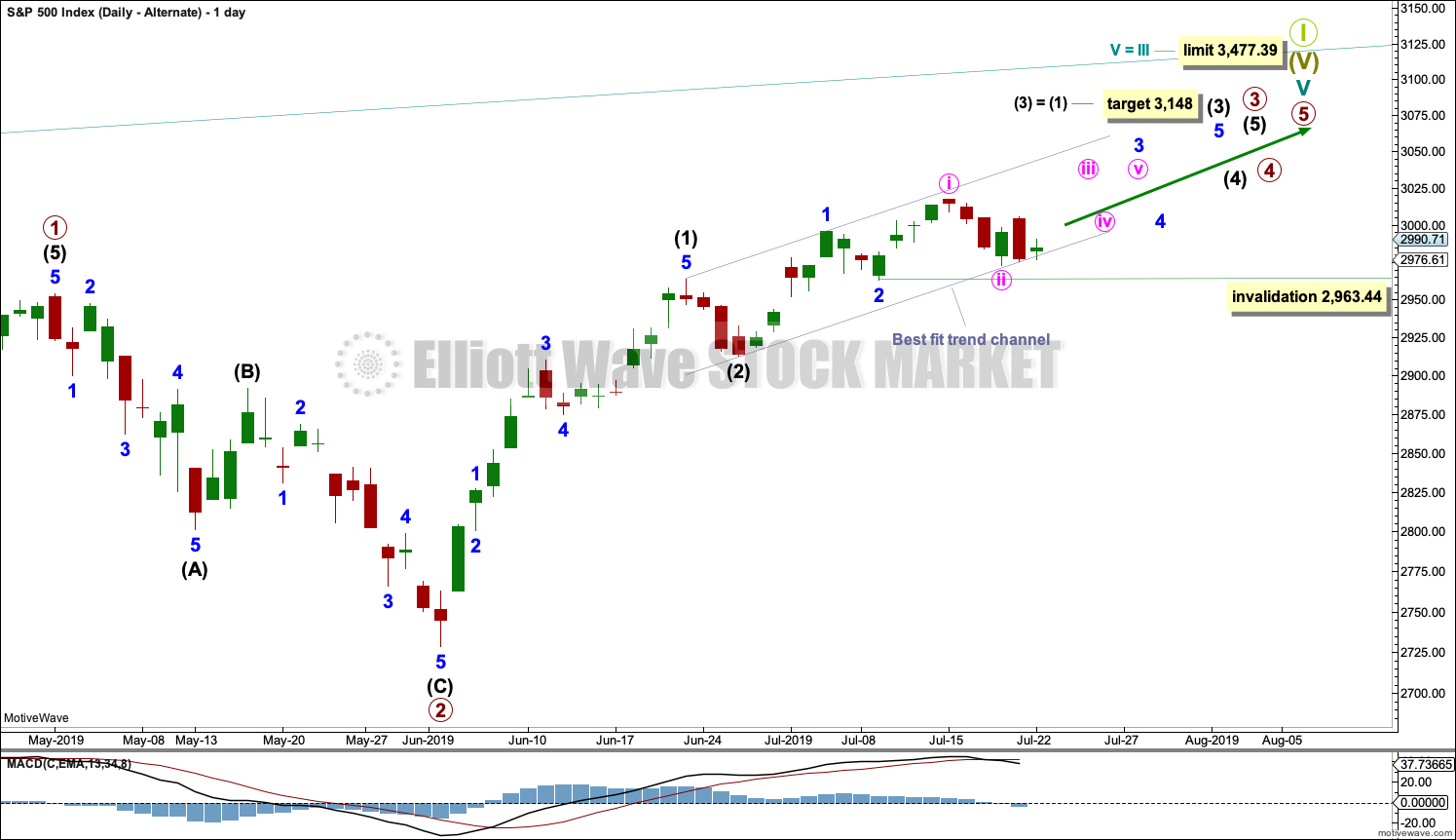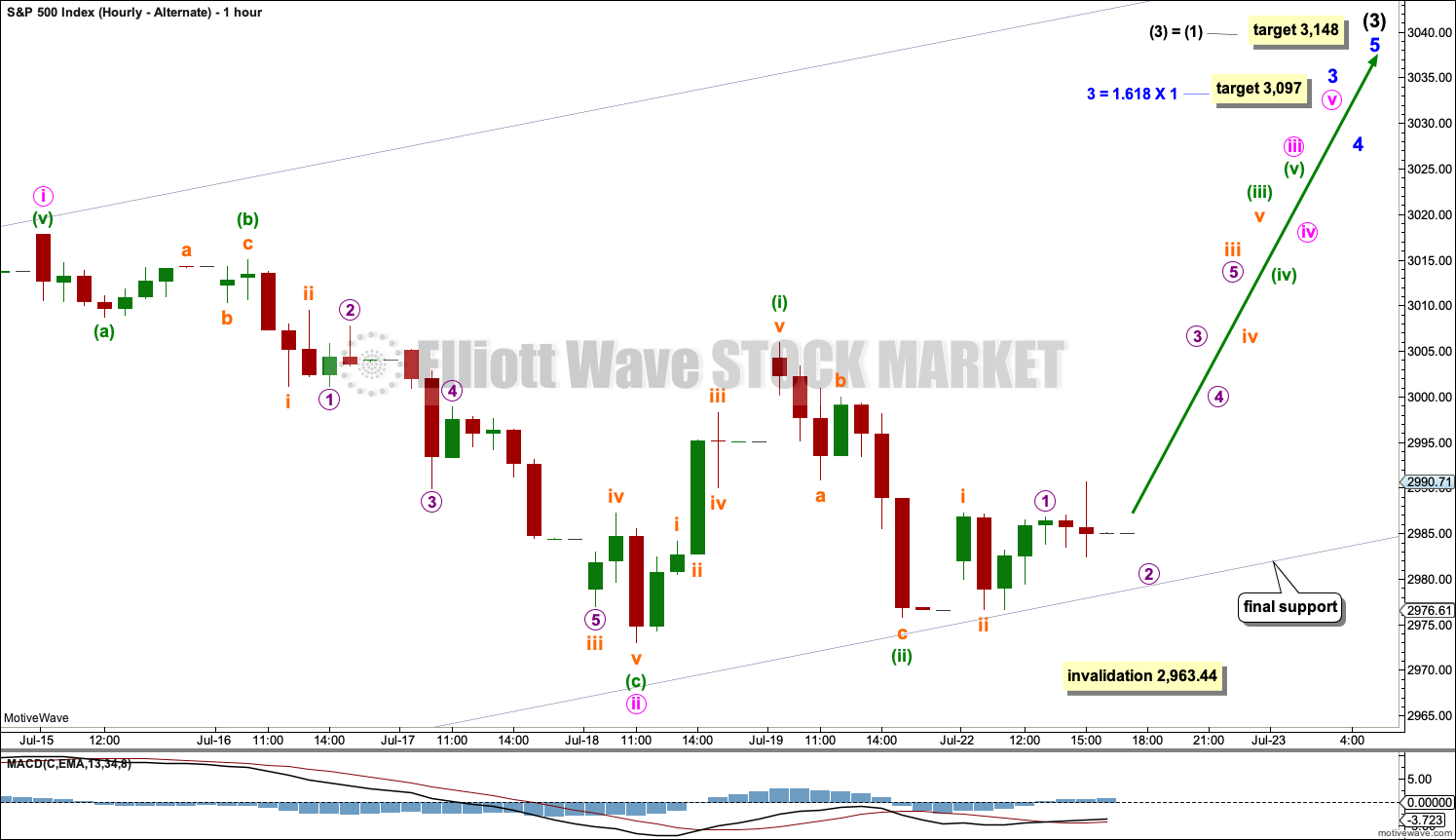A small inside day leaves the Elliott wave counts unchanged.
Summary: A deeper and more time consuming correction may reach to 2,839 or below. This has support from some bearish divergence between price and all of the AD line, VIX and On Balance Volume, and a Bearish Engulfing candlestick pattern on the weekly chart.
A bullish Elliott wave count remains valid while price remains above 2,963.44. For this count, a short-term target for the middle of a third wave to end is now at 3,097. A mid-term target for a third wave at intermediate degree is at 3,148.
The biggest picture, Grand Super Cycle analysis, is here.
Monthly charts were last published here, with video here. There are two further alternate monthly charts here, with video here.
ELLIOTT WAVE COUNTS
The two weekly Elliott wave counts below will be labelled First and Second. They may be about of even probability. When the fifth wave currently unfolding on weekly charts may be complete, then these two wave counts will diverge on the severity of the expected following bear market. To see an illustration of this future divergence monthly charts should be viewed.
FIRST WAVE COUNT
WEEKLY CHART
The basic Elliott wave structure consists of a five wave structure up followed by a three wave structure down (for a bull market). This wave count sees the bull market beginning in March 2009 as an incomplete five wave impulse and now within the last fifth wave, which is labelled cycle wave V. This impulse is best viewed on monthly charts. The weekly chart focusses on the end of it.
Elliott wave is fractal. This fifth wave labelled cycle wave V may end a larger fifth wave labelled Super Cycle wave (V), which may end a larger first wave labelled Grand Super Cycle wave I.
The teal Elliott channel is drawn using Elliott’s first technique about the impulse of Super Cycle wave (V). Draw the first trend line from the end of cycle wave I (off to the left of the chart, the weekly candlestick beginning 30th November 2014) to the end of cycle wave III, then place a parallel copy on the end of cycle wave II. This channel perfectly shows where cycle wave IV ended at support. The strongest portion of cycle wave III, the end of primary wave 3, overshoots the upper edge of the channel. This is a typical look for a third wave and suggests the channel is drawn correctly and the way the impulse is counted is correct.
Within Super Cycle wave (V), cycle wave III is shorter than cycle wave I. A core Elliott wave rule states that a third wave may never be the shortest. For this rule to be met in this instance, cycle wave V may not be longer in length than cycle wave III. This limit is at 3,477.39.
Within cycle wave V, primary waves 1 and 2 may now be complete. Within primary wave 3, no second wave correction may move beyond its start below 2,728.81.
Cycle wave V may subdivide either as an impulse or an ending diagonal. Impulses are much more common. Ending diagonals normally have second and fourth waves that are deep; the common depth is from 0.66 to 0.81 the prior wave. So far a correction within cycle wave V has not been deeper than 0.5, so a diagonal at this stage looks very unlikely (but remains possible).
In historic analysis, two further monthly charts have been published that do not have a limit to upwards movement and are more bullish than this wave count. Members are encouraged to consider those possibilities (links below summary) alongside the wave counts presented on a daily and weekly basis.
Daily charts below will now focus on price movement from the high of primary wave 1.
DAILY CHART
Cycle wave V must subdivide as a five wave motive structure. Within that five wave structure, primary waves 1 and 2 may be complete.
Primary wave 3 must move above the end of primary wave 1 (this rule has now been met). Primary wave 3 may only subdivide as an impulse.
Within the impulse of primary wave 3, intermediate wave (1) may be complete.
It is possible that intermediate wave (1) was over at the last high as a leading contracting diagonal. Within the diagonal, all sub-waves appear to be zigzags, as they most commonly are within leading diagonals. Minor wave 4 overlaps minor wave 1 price territory, as it must within a diagonal. The trend lines converge. This structure meets all Elliott wave rules.
Second wave corrections following leading diagonals in first wave positions are commonly very deep. Intermediate wave (2) may be expected to reach down to the 0.618 Fibonacci ratio of intermediate wave (1) or below.
Intermediate wave (2) may not move beyond the start of intermediate wave (1) below 2,728.81.
Intermediate wave (2) may last a few weeks.
HOURLY CHART
Intermediate wave (2) should be expected to be relatively time consuming and deep, and so minor wave A would most likely be incomplete.
Intermediate wave (2) would most likely subdivide as a zigzag, although it may be any Elliott wave corrective structure except a triangle. A zigzag subdivides 5-3-5.
Minor wave A would most likely subdivide as a five wave impulse. Within minor wave A, minute waves i and ii may be complete. Within minute wave ii, minuette waves (i) and (ii) may be complete. If minuette wave (ii) moves higher as a double zigzag, then it may not move beyond the start of minuette wave (i) above 3,006.02.
ALTERNATE DAILY CHART
It remains possible that within primary wave 3 both intermediate waves (1) and (2) are complete. Within intermediate wave (3), both minor waves 1 and 2 may be complete. Within minor wave 3, minute wave ii should be over at the last low if it is to remain within the best fit channel.
Minute wave ii may not move beyond the start of minute wave i below 2,963.44.
ALTERNATE HOURLY CHART
This wave count now sees a series of seven overlapping first and second waves complete. This wave count now expects explosive upwards movement this week.
A new all time high, which has some support from volume, would indicate this wave count should be correct. At that stage, targets may be used (calculated to expect common Fibonacci Ratios).
SECOND WAVE COUNT
WEEKLY CHART
This weekly chart is almost identical to the first weekly chart, with the sole exception being the degree of labelling.
This weekly chart moves the degree of labelling for the impulse beginning in March 2009 all down one degree. This difference is best viewed on monthly charts.
The impulse is still viewed as nearing an end; a fifth wave is still seen as needing to complete higher. This wave count labels it primary wave 5.
TECHNICAL ANALYSIS
WEEKLY CHART

Click chart to enlarge. Chart courtesy of StockCharts.com.
Last week completes a strong Bearish Engulfing candlestick pattern. Coming after an upwards movement, this is a reversal pattern. It has support from volume; it is taken seriously in this analysis.
The red line illustrating bearish divergence is also a resistance line, which was perfectly met last week.
Longer-term bearish divergence between price and RSI fits the Elliott wave count: the most extreme reading from RSI corresponds with the end of a third wave, and now a fifth wave at cycle or primary degree exhibits some weakness compared to the third wave.
DAILY CHART

Click chart to enlarge. Chart courtesy of StockCharts.com.
Volume still suggests the pullback is still not over, although today another bullish signal from On Balance Volume suggests downwards movement may be limited. If On Balance Volume breaks below support, that would be bearish for the short term.
BREADTH – AD LINE
WEEKLY CHART

Click chart to enlarge. Chart courtesy of StockCharts.com. So that colour blind members are included, bearish signals
will be noted with blue and bullish signals with yellow.
Bear markets from the Great Depression and onwards have been preceded by an average minimum of 4 months divergence between price and the AD line with only two exceptions in 1946 and 1976. With the AD line making new all time highs again this week, the end of this bull market and the start of a new bear market is very likely a minimum of 4 months away, which is mid November 2019.
In all bear markets in the last 90 years there is some positive correlation (0.6022) between the length of bearish divergence and the depth of the following bear market. No to little divergence is correlated with more shallow bear markets. Longer divergence is correlated with deeper bear markets.
If a bear market does develop here, it comes after no bearish divergence. It would therefore more likely be shallow.
Last week the AD line again makes new all time highs with price. Upwards movement has good support from rising market breadth, indicating a healthy bull market.
Last week price has moved higher with a higher high and a higher low, although the candlestick has closed red. The AD line has declined. This is short-term bearish divergence.
Mid caps remain below their all time high of 24th April 2019, and small caps remain below their all time high of 25th February 2019. Weakness is beginning to develop in small caps and mid caps. This is normal behaviour during the later stages of a bull market, and may be expected to develop further before the bull market may end. Tops are a process and that process may last months to even years.
DAILY CHART

Click chart to enlarge. Chart courtesy of StockCharts.com. So that colour blind members are included, bearish signals
will be noted with blue and bullish signals with yellow.
Breadth should be read as a leading indicator.
Short-term bearish divergence remains and has not yet been followed by any downwards movement. It may yet be followed by downwards movement in the next one to few days.
Today price completed an inside day and the AD line has declined. This is bearish for the short term.
VOLATILITY – INVERTED VIX CHART
WEEKLY CHART

Click chart to enlarge. Chart courtesy of StockCharts.com. So that colour blind members are included, bearish signals
will be noted with blue and bullish signals with yellow.
The all time high for inverted VIX (which is the same as the low for VIX) was on 30th October 2017. There is now nearly one year and eight months of bearish divergence between price and inverted VIX.
The rise in price is not coming with a normal corresponding decline in VIX; VIX remains elevated. This long-term divergence is bearish and may yet develop further as the bull market matures.
This divergence may be an early warning, a part of the process of a top developing that may take years. It may not be useful in timing a trend change.
Last week inverted VIX has moved lower while price has moved higher. This divergence is bearish.
DAILY CHART

Click chart to enlarge. Chart courtesy of StockCharts.com. So that colour blind members are included, bearish signals
will be noted with blue and bullish signals with yellow.
Bearish divergence noted in last analysis has not yet been followed by any downwards movement. It may be in the next one to few days.
Today price has completed an inside day, but inverted VIX has moved higher. Inverted VIX has not made a new high, so there is no new divergence, but a decline in VIX today is bullish for the short term.
Because today the AD line and inverted VIX disagree more weight is given to the AD line than inverted VIX; it seems to be more reliable lately.
DOW THEORY
Dow Theory confirmed a bear market in December 2018. This does not necessarily mean a bear market at Grand Super Cycle degree though; Dow Theory makes no comment on Elliott wave counts. On the 25th of August 2015 Dow Theory also confirmed a bear market. The Elliott wave count sees that as part of cycle wave II. After Dow Theory confirmation of a bear market in August 2015, price went on to make new all time highs and the bull market continued.
DJIA: 23,344.52 – a close on the 19th of December at 23,284.97 confirms a bear market.
DJT: 9,806.79 – price has closed below this point on the 13th of December.
S&P500: 2,532.69 – a close on the 19th of December at 2,506.96 provides support to a bear market conclusion.
Nasdaq: 6,630.67 – a close on the 19th of December at 6,618.86 provides support to a bear market conclusion.
With all the indices having moved higher following a Dow Theory bear market confirmation, Dow Theory would confirm a bull market if the following highs are made:
DJIA: 26,951.81 – a close above this point has been made on the 3rd of July 2019.
DJT: 11,623.58 – to date DJT has failed to confirm an ongoing bull market.
S&P500: 2,940.91 – a close above this point was made on the 29th of April 2019.
Nasdaq: 8,133.30 – a close above this point was made on the 26th of April 2019.
Published @ 08:00 p.m. EST.
—
Careful risk management protects your trading account(s).
Follow my two Golden Rules:
1. Always trade with stops.
2. Risk only 1-5% of equity on any one trade.
—
New updates to this analysis are in bold.







Hourly chart updated:
I’m moving the invalidation point back up to the ATH. A little more upwards movement may complete a second wave correction.
No sure what’s happening except that price is staying cleanly inside the up trend channel in SPX. No sign yet of any significant intermediate 2 break down to the down side. So far…
Yes and ECB this Thu & Fed next week, sellers has it against them…
They have not been able to follow through on the Friday downside
Maybe maybe maybe RUT has finished a 2 wave. Some decent bottom structure and it appears close to starting to break pivot support/resistance and then the down trend line.
Report in the Washington Post today that all-time heat records are being set all around the world right now.
Coming like a freight train folks. Only hope is we do the work needed. Don’t eat cows or drink milk. Don’t drive gasoline powered cars (including hybrids). Don’t fly on airplanes. Plant trees. Install solar. Don’t use natural gas (switch to electric power). Plant more trees (we need over 1 trillion new trees, quickly). No one is going to stop the pollution of the atmosphere except you and I, because the gov’ts of the world serve the corporations first and foremost, and their goal is short term profits with no real concern for the future (if they don’t do that, the leadership gets fired and replaced). So it’s up to us at a grassroots level to change our behavior to preserve a livable habitat on this planet. Change, and work your tail off to get your friends, family, and neighbors to change too. All land life on this planet depends on it.
Yes, this pertains to the markets. When the real estate wealth destruction really starts kicking in, the market will finally start discounting this future. That will be pretty much the beginning of the final recession/depression, the one we as a civilization never come out of. How much longer until that starts, well, that’s a key reason I follow Lara’s work! The market will tell us…
So please, take action, and promote action by all those around you. Only we can save this planet.
Oh dear!
The wave count that sees Grand Super Cycle wave I coming to an end could see this begin in about a year or so.
The wave count that sees only cycle wave I within Super Cycle wave V coming to an end, could see this all begin in another 10-30 years or so.
Nature has given us the technology to fix this. If we all planted a good number of trees (instead of chopping them down) we could fix this. But we need to do it NOW.
According to my solar panel app…. in two years I have saved 17,609 kg of CO2 emission, the equivalent of planting 977 trees
Not sure if its accurate
Hi Kevin,
I’m in. Excellent awareness points! In a few weeks I will discontinue my car ownership. In settings that support mass transit, I will use it. In settings that require surface transport to reach locations that are unserved, I will use a motorcycle. For me, aircraft are unavoidable.
I believe that our very best global source of renewable energy is nuclear. I’m referring to energy that powers nations. It’s a whole different ballgame than seeking an off-grid solution for an individual’s power needs.
I am concerned that our inability to control wildfires is damaging the environment. Last year in the USA there were 8,800,000 acres burned in 58,000 wildfires. Our prevention and response are very lacking.
some good stock set ups and triggers, OZM, CHRS, see my website main page specktrading dot com.
There is a bit of a head and shoulder’s top forming…this is /ES 4 hour with overnight data.
#1… now what?